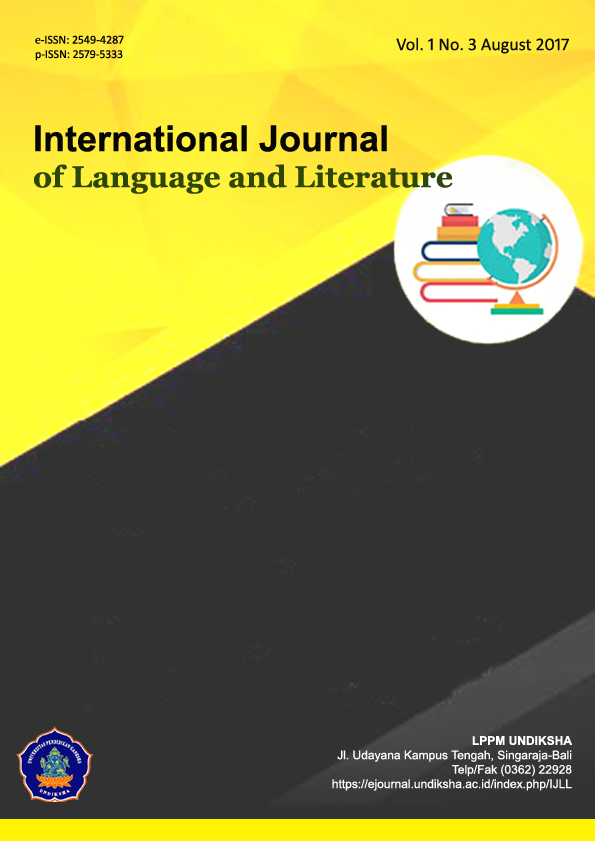THE EFFECT OF STAD UPON STUDENTS WITH DIFFERENT LEVEL OF SELF ESTEEM TOWARD READING COMPREHENSION OF ELEVENTH GRADE STUDENTS OF SMAN 1 KEDIRI TABANAN IN THE ACADEMIC YEAR 2013/2014
DOI:
https://doi.org/10.23887/ijll.v1i3.12547Keywords:
Students Team Achievement Divison (STAD), self esteem, reading comprehension, conventional method.Abstract
The purpose of the study is to investigate the effect of STAD treatment on reading comprehension in eleventh grade students of SMAN 1 Kediri Tabanan in academic year 2013/2014. Students’ self esteem was also put into consideration and was also investigated as the moderator variable. There were 7 classes as the population and by using intact group random sampling, two classes were chosen as the samples of the investigation and were divided into experimental and control group. In total, there were seventy six students who were selected as the representative of the whole population. To collect the data, the study used reading comprehension test which was administered at the end of teaching sessions. In investigating the result, two statistical methods were applied namely descriptive and inferential statistics by using t-test, product moment and one way ANCOVA. At the end of investigation, it was found that, first, there was a significant difference in reading comprehension between the students who were treated by using STAD and the students who were treated by conventional method. Second, viewed from students self esteem which gave minimum contribution toward the difference of reading comprehension ‘s score between STAD class and conventional class, it was found that there was no significant correlation between self esteem and teaching method, third there was significant correlation between students’ self esteem and reading comprehension for all of the students who were taught by STAD and conventional method, there was no correlation between students’ self esteem and reading comprehension for the students who were taught by STAD. Last, there was significant correlation between students’ self esteem and reading comprehension for the students who were taught by conventional method.
References
Andreas, Veronica. 2003. The Influences of Affective Variables on FL/ESL Teaching and Learning. The journal of Imagination in Language Learning and Teaching Vol. VII 01 – 03
Brown, H.Douglas. 1980. Principles of Language learning and Teaching. New Jersey: Prentice-Hall, Inc.
Brown, H.Douglas. 1980. Principles of Language learning and Teaching.Fourth Edition. New York, Pearson Longman.
Coopersmith, Stanley. 2005. Coopersmith Self-Esteem Inventories Manual. Retrieved in Wednesday, October 26,2011.from http://www.mindgarden.com/products/cseis.htm
Cunningham, Anne E; Stanovich, Keith E. 2011. Journal of Direct Instruction. The American Federation of Teachers.
Dantes, Nyoman. 2012. Metode Penelitian. Yogyakarta. Andi Press.
Ellis, Rod. 1997. Second Language Acquisition. Oxford University Press.
Freeman, D Larsen. 2000. Technique and Principles in Language Teaching. Oxford ; Oxford University Press.
Geva, Esther. 2006. Learning to Read in a Second Language: Research, Implications, and Recommendations for Services. Canada: University of Toronto
Grabe, William. 2009. Reading In Second Language ; Moving From Theory to Practice. New York: Cambridge University Press
Huda, Miftahul. 2013. Model-Model Pengajaran dan Pembelajaran. Yogyakarta: Pustaka Pelajar
Koyan, I Wayan. 2012. Statistik Pendidikan ; Teknik Analisis Data Kuantitatif. Singaraja : Universitas Pendidikan Ganesha Press.
Krashen, Stephen D. 1995. The Natural Approach ; Language Acquisition in The Classroom. Prentice Hall Europe.
Murcia, Marianne C. 2001. Teaching English as a Second or Foreign Language. Boston: Heinle & Heinle
Nevills, Pamela; Wolfe, Patricia. 2004. Building for The Reading Brain. California: Corwin Press
Nutall, Christine.1985.Teaching Reading Skill in A Foreign Language.London:Heinemann
Pang, Elizabeth S; Muaka, Angaluki; Benhardt, Elizabeth. B; Kamil, Michael. L. 2003.Teaching Reading. France: Sadag
Slavin, E.Robert. 2005. Educational Psychology, Theory and Practice. Boston :Pearson Longman
Soureshjani, H Kamal. 2011. An Investigation into the Relationship between Self-esteem, Proficiency Level, and the Reading Ability of Iranian EFL Language Students. Finland : Academy Publisher
TEFLIN journal. 2014. TEFLIN Publication Division. English Department, Faculty of Letters, Universitas Negeri Malang.
Undang-Undang No 20 Tahun 2003 Tentang Sistem Pendidikan Nasional
Downloads
Published
How to Cite
Issue
Section
License
IJLL Journal provides immediate open access to its content on the principle that making research freely available to the public to supports a greater global exchange of knowledge.

This work is licensed under a Creative Commons Attribution-ShareAlike 4.0 International License








